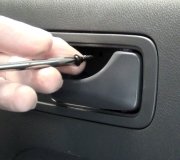I think you just listed the problem. You used the yellow / black wire for the ground. I mentioned previously there is no ground wire in those two plugs. You have to use the braided strap that's bolted on the back, or the ground wire that's clipped onto a terminal on the back. The wire you used is for the tail lights. When you turn on the head lights at night, 12 volts shows up on that wire to tell the display to dim. By connecting it to your new radio's ground, the tail light wire is shorted to ground through the outer shield on the antenna cable.
I see where you found that yellow / black wire. It's shown on this first diagram. This is the wire I drew as the black / yellow wire, but as I said, the colors can change from year to year.
The second diagram shows the dash lights. As for blown fuses, I don't see any dedicated just for the instrument cluster lights, but I think I know why they're dead. For reference, the third through seventh drawings are for the Junction Box. That's the inside fuse box in front of the brake pedal. Drawings 8 through 13 are for the Power Distribution Center, (PDC). That's the fuse box under the hood.
Starting with the '96 models, Chrysler started using a two-terminal semiconductor circuit breaker called a "positive temperature coefficient", or "PTC". They have a current rating like a fuse, but the instant current exceeds that rating, the device instantly goes open circuit, the same as if a fuse were to blow. The difference is when the short is removed, it goes right back to acting like a piece of wire and the circuit goes back to working normally.
There's also a lot of stuff being run by a Body Computer. On some circuits, if they detect a short, they won't turn that circuit on.
The first thing to do is disconnect the yellow / black wire and cap the end of it. That wire, and the orange wire, aren't used with aftermarket radios. Now check if the instrument cluster lights are working. If they are, they are protected by a PTC, so no further repairs are needed for that problem. If they still aren't working, start by checking the lower row of fuses in the Junction block. To make that easier, they all have two small holes on top for test points. Use a test light to check each test point. Here's links to articles that explain this better, if you need it:
https://www.2carpros.com/articles/how-to-use-a-test-light-circuit-tester
https://www.2carpros.com/articles/how-to-check-a-car-fuse
If you find 12 volts on both sides of a fuse, that one is okay. If you find 0 volts on both sides, that circuit is turned off. The lights have to be turned on during this test. You're looking for any fuse that has 12 volts on one side and 0 volts on the other test point.
As for your problem uploading images, I copy and paste them into the MS Word typing program where I can add arrows and callouts. Once all the additions are grouped together, I copy and paste that into the MS Paint program. When you go to save it, you can open a drop-down menu to select to save it as a "JPEG" file. That format, and I think one of the other formats can be uploaded. I can walk you through that if necessary.
Images (Click to make bigger)
Wednesday, May 12th, 2021 AT 6:27 PM

















